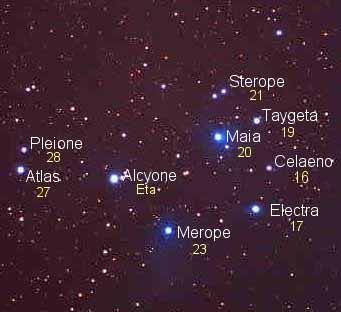
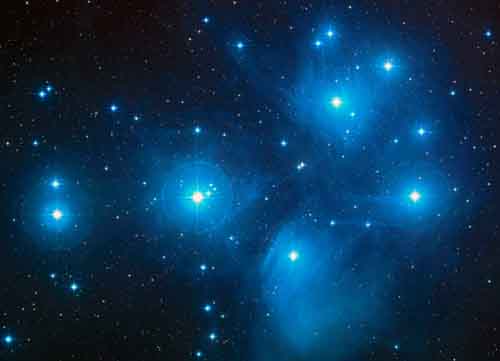
The Pleiades also known as M45 or the Seven Sisters, is the name of an open cluster in the constellation of Taurus. It is among the nearest to the Earth of all open clusters, probably the best known and certainly the most striking to the naked eye. This asterism is sometimes referred to as the Maia Nebula, perhaps erroneously considering that the reflection nebulosity surrounding Maia is extrinsic.
The cluster is dominated by hot blue stars, which have formed within the last 100 million years. Dust that forms faint reflection nebulosity around the brightest stars was thought at first to be left over from the formation of the cluster but is now known to be an unrelated dust cloud that the stars are currently passing through. Astronomers estimate that the cluster will survive for about another 250 million years, when it will have dispersed due to gravitational interactions with the spiral arms of the galaxy and giant molecular clouds.
Observational History The Pleiades are a prominent sight in the Northern Hemisphere in winter and in the Southern Hemisphere in summer, and have been known since antiquity to cultures all around the world, including the Maori and Australian Aborigines, the Chinese, the Maya called them Tzab-ek, the Aztec and the Sioux of North America. Some Greek astronomers considered them to be a distinct constellation, and they are mentioned by Hesiod, and in Homer's Iliad and Odyssey. They are also mentioned three times in the Bible (Job 9:9, 38:31; Amos 5:8).
The Pleiades (Krittika) are particularly revered in Hindu mythology as the six mothers of the war god Skanda, who developed six faces for each one of them. In Islam The prominent commentators of the Noble Quran like Ibn Kathir mention At-thuraiya (the Pleiades) to mean the Star in Najm 53:1 according to tafsir of Mujahid ibn Jabr, as confirmed by Al-Haafidh Ibn Hajar in Fath al-Bari. Also there is a hadith in relation to verse of Quran Al-Jumua 62:3 suggests that if faith were near At-thuraiya (the Pleiades), then a descendent of these folk, i.e, Salman's Salman Al-Farsi would attain it.
A Spitzer image of the Pleiades in infrared light, showing the associated dust. Credit: NASA/JPL-Caltech They have long been known to be a physically related group of stars rather than any chance alignment. The Reverend John Michell calculated in 1767 that the probability of a chance alignment of so many bright stars was only 1 in 500,000, and so correctly surmised that the Pleiades and many other clusters of stars must be physically related. When studies were first made of the stars' proper motions, it was found that they are all moving in the same direction across the sky, at the same rate, further demonstrating that they were related.
Charles Messier measured the position of the cluster and included it as M45 in his catalogue of comet-like objects, published in 1771. Along with the Orion Nebula and the Praesepe cluster, Messier's inclusion of the Pleiades has been noted as curious, as most of Messier's objects were much fainter and more easily confused with comets - something which seems scarcely possible for the Pleiades. One possibility is that Messier simply wanted to have a larger catalogue than his scientific rival Lacaille, whose 1755 catalogue contained 42 objects, and so he added some bright, well-known objects to boost his list.
Distance The distance to the Pleiades is an important first step in the so-called cosmic distance ladder, a sequence of distance scales for the whole universe. The size of this first step calibrates the whole ladder, and the scale of this first step has been estimated by many methods. As the cluster is so close to the Earth, its distance is relatively easy to measure. Accurate knowledge of the distance allows astronomers to plot a Hertzsprung-Russell Diagram for the cluster which, when compared to those plotted for clusters whose distance is not known, allows their distances to be estimated. Other methods can then extend the distance scale from open clusters to galaxies and clusters of galaxies, and a cosmic distance ladder can be constructed. Ultimately astronomers' understanding of the age and future evolution of the universe is influenced by their knowledge of the distance to the Pleiades.
Results prior to the launch of the Hipparcos satellite generally found that the Pleiades were about 135 parsecs away from Earth. Hipparcos caused consternation among astronomers by finding a distance of only 118 parsecs by measuring the parallax of stars in the cluster, a technique which should yield the most direct and accurate results. Later work has consistently found that the Hipparcos distance measurement for the Pleiades was in error, but it is not yet known why the error occurred. The distance to the Pleiades is currently thought to be the higher value of about 135 parsecs.
Composition The cluster is about 12 light years in diameter and contains approximately 500 stars in total. It is dominated by young, hot blue stars, up to 14 of which can be seen with the naked eye depending on local observing conditions. The arrangement of the brightest stars is somewhat similar to Ursa Major and Ursa Minor. The total mass contained in the cluster is estimated to be about 800 solar masses.
The cluster contains many brown dwarfs, which are objects with less than about 8% of the Sun's mass, not heavy enough for nuclear fusion reactions to start in their cores and become proper stars. They may constitute up to 25% of the total population of the cluster, although they contribute less than 2% of the total mass. Astronomers have made great efforts to find and analyse brown dwarfs in the Pleiades and other young clusters, because they are still relatively bright and observable, while brown dwarfs in older clusters have faded and are much more difficult to study.
Also present in the cluster are several white dwarfs. Given the young age of the cluster normal stars are not expected to have had time to evolve into white dwarfs, a process which normally takes several billion years. It is believed that, rather than being individual low- to intermediate-mass stars, the progenitors of the white dwarfs must have been high-mass stars in binary systems. Transfer of mass from the higher-mass star to its companion during its rapid evolution would result in a much quicker route to the formation of a white dwarf, although the details of this supposed transfer from a deeper gravity well to a lesser are unexplained.
Age and Future Evolution Ages for star clusters can be estimated by comparing the H-R diagram for the cluster with theoretical models of stellar evolution, and using this technique, ages for the Pleiades of between 75 and 150 million years have been estimated. The spread in estimated ages is a result of uncertainties in stellar evolution models. In particular, models including a phenomenon known as convective overshoot, in which a convective zone within a star penetrates an otherwise non-convective zone, result in higher apparent ages.
Another way of estimating the age of the cluster is by looking at the lowest-mass objects. In normal main sequence stars, lithium is rapidly destroyed in nuclear fusion reactions, but brown dwarfs can retain their lithium. Due to its very low ignition temperature of 2.5 million kelvins, the highest-mass brown dwarfs will burn lithium eventually, and so determining the highest mass of brown dwarfs still containing lithium in the cluster can give an idea of its age. Applying this technique to the Pleiades gives an age of about 115 million years.
The cluster's relative motion will eventually lead it to be located, as seen from Earth many millennia in the future, passing below the feet of what is currently the constellation of Orion. Also, like most open clusters, the Pleiades will not stay gravitationally bound forever, as some component stars will be ejected after close encounters and others will be stripped by tidal gravitational fields. Calculations suggest that the cluster will take about 250 million years to disperse, with gravitational interactions with giant molecular clouds and the spiral arms of the galaxy also hastening its demise.
Names and Technical Information The nine brightest stars of the Pleiades are named for the Seven Sisters of Greek mythology: Sterope, Merope, Electra, Maia, Taygete, Celaeno and Alcyone, along with their parents Atlas and Pleione. As daughters of Atlas, the Hyades were sisters of the Pleiades. The name of the cluster itself is of Greek origin, though of uncertain etymology. Suggested derivations include: from plein, to sail, making the Pleiades the "sailing ones"; from pleos, full or many; or from peleiades, flock of doves.
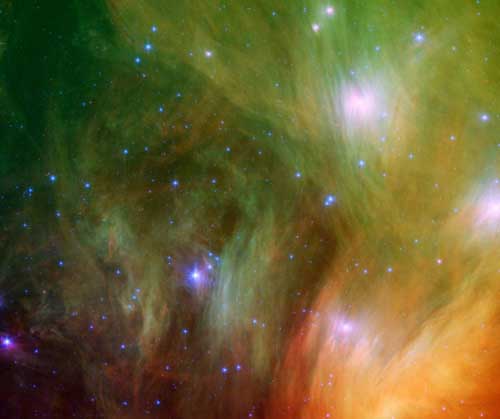
Seven Dusty Sisters NASA - April 13, 2007
The Pleiades in Folklore Ancient civilizations looked to the heavens as guides for their daily lives. They attributed many things to these gods who were both god and bad - kind and harsh. They created mythological tales about those who came from the different star systems. They believed that the gods lived in the heavens and sometimes flew down to the planet bringing messages of teaching or warnings of disasters. These people communicated with their gods through meditation and dreamtime. They believed that the gods would one day return.
The alignment in the heavens is like a blueprint upon which those on the planet can plan their daily, weekly, monthly, and yearly activities. The heavens were also the way they plotted their seasons so they would know when to plant and when to harvests, when the waters would come and when it would be dry. In essence they worshipped those from the skies, the Pleiades being a major factor for many civilizations.
The Pleiades' high visibility in the night sky has guaranteed it a special place in many cultures, both ancient and modern.
The Pleiades are mentioned three times in the Bible, twice by name and once by reference, in Job 9:9, again in Job 38:31, and alluded to in Amos 5:8.
Hebrew - Kimah: a cluster (Hebrew)
Egypt - the Pleaides represent the goddess Net or Neith, the "divine mother and lady of heaven".
Japan - the word for Pleiades translates to 'Subaru'. If you examine the insignia logo for this line of cars, you'll see a stylized symbol of the Seven Sisters as ancient mythology meets modern industry.
China - Kimah - The Pleiades seem to be the among the first star mentioned in astronomical literature, appearing in Chinese annals of 2357 B.C. China - The Blossom Stars and Flower Stars
Rome - The Bunch of Grapes and The Spring Virgins
Old English, Old German, Russian, Czech and Hungarian - The Hen and Chicks
To the Vikings, they were Freya's hens, and their name in many old European languages compares them to a hen with chicks.
To the Bronze Age people of Europe, such as the Celts (and probably considerably earlier), the Pleiades were associated with mourning and with funerals, since at that time in history, on the cross-quarter day between the autumn equinox and the winter solstice, which was a festival devoted to the remembrance of the dead, the cluster rose in the eastern sky as the sun's light faded in the evening. It was from this acronychal rising that the Pleiades became associated with tears and mourning. As a result of precession over the centuries, the Pleiades no longer marked the festival, but the association has nevertheless persisted, and accounts for the significance of the Pleiades astrologically.
The early Monte Alto Culture and others in Guatemala such as Ujuxte and Takalik Abaj, made its early observatories, using the Pleiades and Eta Draconnis as reference, they were called the seven sisters, and thought to be their original land.
Heliacal risings very often mark important calendar points for ancient peoples. The heliacal rising of the Pleiades (around June) also begins the new year for the Maori of New Zealand, who call the Pleiades Matariki. There is an analogous holiday in Hawaii known as Makalii.
Indigenous Australians: Depending on the tribe or clan, some Indigenous Australian peoples believed the Pleiades were a woman who had been nearly raped by Kidili, the man in the moon. Another version, often painted by Gabriella Possum Nungurayyi as this is her dreaming (or creation story), daughter of the late Clifford Possum Tjapaltjarri from the Central desert art movement of Papunya, depicts the story of seven Napaltjarri sisters being chased by a man named Jilbi Tjakamarra. He would practice love magic to seduce the sisters but they had no intention of being with him and ran away. They sat down at Uluru to search for honey ants but when they saw Jilbi, they went to Kurlunyalimpa and with the spirits of Uluru, transformed into stars. Jilbi transforms himself into what is commonly known as the Morning Star in Orion's belt, thus continuing to chase the seven sisters across the sky. Pitjantjatjara tribe - Kungkarungkara: the ancestral women. Australian Aboriginal - Adnyamathanha tribe - Makara: The wives of stars in the Orion constellation
In Japan, the Pleiades are known as Subaru, and have given their name to the car manufacturer whose logo incorporates six stars. Subaru Telescope, located in Mauna Kea Observatory on Hawaii, is named after the Pleiades also.
In Chinese constellations, they are mao, the Hairy Head of the white tiger of the West, while the name of the Hindu God Kartikeya means him of the Pleiades.
South Africa - Khuseti: the stars of rain, or rain bearers. (Khoikhoi tribe)
In the Swahili language of East Africa they are called "kilimia" which means "digging stars" as their visibility was taken as a sign to prepare digging as the onset of the rain was near.
Hindu - The Flames of Agni (the god of Fire): the divinities of fire in its beneficent form and the wet nurses for Kumara, the god of War. Also The General of the Celestial Armies. In Western astrology they represent coping with sorrow and were considered a single one of the medieval fixed stars. As such, they are associated with quartz and fennel. In Indian astrology the Pleiades were known as the asterism (nakshatra) Krittika (which in Sanskrit is translated as "the cutters.") The Pleiades are called the star of fire, and their ruling deity is the Vedic god Agni, the god of the sacred fire. It is one of the most prominent of the nakshatras, and is associated with anger and stubbornness.
The word has acquired a meaning of "multitude", inspiring the name of the French literary movement La Pleiade and an earlier group of Alexandrian poets, the Alexandrian Pleiad.
Aztec - Tianquiztli: 'marketplace' or 'gathering place'
Inca - The seed scatterer or sower
Paraguayan - Abiponestribe worshipped them as their ancestors.
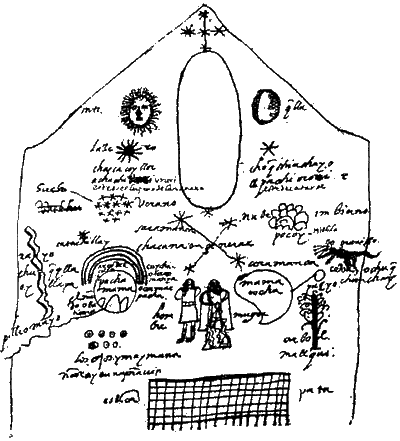 Peru - Verano - which means summer, or dry season - possibly in association with the Pleiades ritual at the summer solstice during the dry season. A Peruvian cosmological chart from around 1613 seems to show the Pleiades. Pachacuti Yamqui, an Inca nobleman, drew the chart to show the objects that were depicted on the temple in Cusco, adding Spanish and Quechua notations.
Peru - Verano - which means summer, or dry season - possibly in association with the Pleiades ritual at the summer solstice during the dry season. A Peruvian cosmological chart from around 1613 seems to show the Pleiades. Pachacuti Yamqui, an Inca nobleman, drew the chart to show the objects that were depicted on the temple in Cusco, adding Spanish and Quechua notations.
Native Americans: The Sioux of North America had a legend that linked the origin of the Pleiades to Devils Tower. According to the Seris (of northwestern Mexico), these stars are seven women who are giving birth. The constellation is known as Cmaamc, which is apparently an archaic plural of the noun cmaam "woman". It was common among the indigenous peoples of the Americas to measure keenness of vision by the number of stars the viewer could see in the Pleiades, a practice which was also used in historical Europe, especially in Greece.
Native Amercians believed in constellations and created ancient star maps. Legend has it that they exist at the center of the Earth or 'Turtle Island'. That beyond them was the sky and that beyond the sky were dimensional portals or sky holes. Beyond the dimensional portals was an area that they call the 'Ocean of Pitch', were the beauty of the night sky and the galaxies spun out towards them. Beyond that were the boundaries of the universe. And that set along the rim at the boundaries of the universe were 4 different extraterrestrial groups.
At the destruction at each of the ages of mankind the people that were pure of heart went down into the buxom of the Earth and there remained protected. According to them they dwelt in the center of the Earth with a group of beings that they call the Ant People. Drawings of the Ant People are remarkable similar to the gray aliens, large heads, little stocky bodies, long spindly fingers, in some cases 4, 5, or 6 digits. Some of these drawings have the indication of telepathic thought waves coming from the beings'.
Early Dakota stories speak of the Tiyami home of the ancestors as being the Pleiades. Astronomy tells us that the Pleiades rise with the sun in May and that when you die your spirit returns south to the seven sisters.
The Hopis called the Pleiadians the 'Chuhukon', meaning those who cling together. They considered themselves direct descendents of the Pleiadians. Hopi Prophecy and Legend
The Navajos named the Pleiades the 'Sparkling Suns' or the 'Delyahey', the home of the 'Black God'.
The Iroquois pray to them for happiness.
The Cree came to have come to Earth from the stars in spirit form first and then became flesh and blood.
They believe that Mythic Mountain is actually the home of the Kachinas [Gods]. This mountain top is sacred. Being the home of the Kachina spirits it is the place where all of the large mythic beings they honor in their rituals land. "We come as clouds to bless the Hopi people" is a quote passed from generation to generation. There are some remarkable drawings that appear to be luminous discs of light in the petroglyphs in the southwest.
Native Americans believed that the home of the Kachinas was on top of a mountain where there were great cloud formations. Today we know that UFO's often hide in what we call Lenticular Clouds. These are cloud formations that resemble UFO's and are said to hide actual spacecraft.
One legend ties the Pleiades to a Savior. On a street in the Holy Land, the Savior smelled the delicious aroma of freshly-baked bread. Entering the shop, the Savior was instantly recognized by the baker who presented Him with a tasty treat and a chance to rest from His labors. In gratitude, the Savior placed the baker, his wife and seven daughters in the Heavens to be safe with Him forever.
Some Native Americans believed that all tribes in North America came from the Pleiades. That they were actually descendents and had been given a task by the Pleiadians to keep the Earth safe.
Another legend tells of seven maidens who were being pursued by a ferocious bear. Kneeling to pray for help, they called on the Indian gods, who raised the ground where they were located high into the air. Angered, the bear clawed at the earth in a vain attempt to reach them. After leaving huge claw marks in the unyielding earth, the bear finally gave up and retreated. The maidens were turned into stars and placed in the sky forever out of harm's way. The site is what we now call the Devil's Tower, scene of the climactic alien visit in the movie 'Close Encounters of the Third Kind.'
Greek Mythology In Greek mythology, the Pleaides represented the Seven Sisters. Greek astronomer Eudoxus of Knidos (c. 400-350 BC) set them apart as a distinct constellation: the Clusterers. Greek sailors were said to consult the skies before setting sail. If the Pleiades were visible, all was well. Otherwise, storm conditions were likely.. They are mentioned in Homer's Iliad and Odyssey.
- Maia - eldest of the seven Pleiades, was mother of Hermes by Zeus
- Electra was mother of Dardanus and Iasion by Zeus.
- Taygete was mother of Lacedaemon, also by Zeus.
- Alcyone was mother of Hyrieus by Poseidon.
- Celaeno was mother of Lycus and Eurypylus by Poseidon.
- Sterope (also Asterope) was mother of Oenomaus by Ares.
- Merope youngest of the seven Pleiades, was wooed by Orion. In other mythic contexts she married Sisyphus and, becoming mortal, faded away. She bore to Sisyphus several sons.
After Atlas was forced to carry the world on his shoulders, Orion began to pursue all of the Pleiades, and Zeus transformed them first into doves, and then into stars to comfort their father. The constellation of Orion is said to still pursue them across the night sky.In the Pleiades star cluster only six of the stars shine brightly, the seventh, Merope, shines dully because she is shamed for eternity for having an affair with a mortal. Some myths also say that the star that doesn't shine is Electra, mourning the death of Dardanus, though a few myths say it is Sterope.
One of the most memorable myths involving the Pleiades is the story of how these sisters became, quite literally, stars. According to some versions of the tale, all seven sisters committed suicide because they were so saddened by either the fate of their father, Atlas, or the loss of their siblings, the Hyades. In turn Zeus, the ruler of the Greek gods, immortalized the sisters by placing them in the sky. There these seven stars formed the constellation known thereafter as the Pleiades.
The Greek poet Hesiod mentions the Pleiades several times in his Works and Days. As the Pleiades are primarily summer stars, they feature prominently in the ancient agricultural calendar.






 The raiding of the site at Huaca Rajada had started several weeks before. A local 36 year-old huaqueros named Ernil Bernal had led a small group of looters to the pyramids. Jobs in the village of Sipan, near the pyramids were scarce and the poverty oppressive. For generations the huaqueros had been looting archaeological locations hoping to find a few gold beads or rare ceramics to sell. That night at Huaca Rajada Ernil and his crew hit the jackpot.
The raiding of the site at Huaca Rajada had started several weeks before. A local 36 year-old huaqueros named Ernil Bernal had led a small group of looters to the pyramids. Jobs in the village of Sipan, near the pyramids were scarce and the poverty oppressive. For generations the huaqueros had been looting archaeological locations hoping to find a few gold beads or rare ceramics to sell. That night at Huaca Rajada Ernil and his crew hit the jackpot.  Dr. Alva now had a choice to make. Common sense argued that he should just fill up the tunnels and hope no more damage would be done to the pyramid until a full excavation could be organized and funded someday in some distant future. Or, Alva could start excavation immediately. If he made the second choice he would have to proceed with no money, little police support and no official permission.
Dr. Alva now had a choice to make. Common sense argued that he should just fill up the tunnels and hope no more damage would be done to the pyramid until a full excavation could be organized and funded someday in some distant future. Or, Alva could start excavation immediately. If he made the second choice he would have to proceed with no money, little police support and no official permission.  Outside the site, which now looked like a armed camp, the villagers gathered and shouted that they wanted their "ancestor's inheritance." The police, in fear, launched tear gas. Tension mounted even more. No help was coming and it seemed as if Alva's men could hold out only one more night before those gathered around the pyramid would overrun it, assaulting the digging crew, and plundering the royal tomb.
Outside the site, which now looked like a armed camp, the villagers gathered and shouted that they wanted their "ancestor's inheritance." The police, in fear, launched tear gas. Tension mounted even more. No help was coming and it seemed as if Alva's men could hold out only one more night before those gathered around the pyramid would overrun it, assaulting the digging crew, and plundering the royal tomb. 

 ourteen Schliemann was apprenticed to a local grocer. When he hurt his back and could no longer lift heavy weights, he moved to Hamburg. Unable to hold a job there because of his injury, he signed on as a cabin boy on a ship. The ship went down during a bad storm off the coast of Holland. Finding his way to Amsterdam he got a poorly-paying job.
ourteen Schliemann was apprenticed to a local grocer. When he hurt his back and could no longer lift heavy weights, he moved to Hamburg. Unable to hold a job there because of his injury, he signed on as a cabin boy on a ship. The ship went down during a bad storm off the coast of Holland. Finding his way to Amsterdam he got a poorly-paying job. 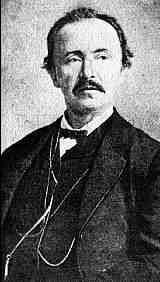
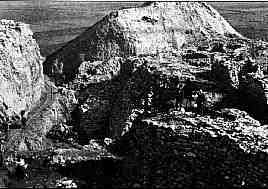
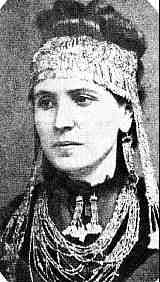
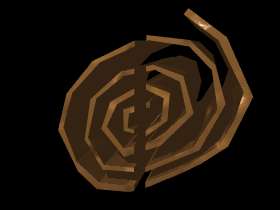 The copper scroll was discovered in 1952 by an expedition sponsored by the Jordan Department of Antiquities. When found ,it was in two parts. Apparently when the scroll was being rolled up, the thin copper sheet snapped into two sections. After almost two-thousand years in the cave, the document was so badly oxidized that it would crumble if anyone attempted to open it. Even while it was still wound up, though, it became apparent to scholars studying what little text could be seen that the scroll was a list of treasure. Despite great enthusiasm to unwind the document and examine the contents, no method could be found that would preserve the manuscript from harm. Finally, after four years of debate, it was decided to send the scroll to Manchester College of Technology in England and have it opened by using a saw to cut it into sections (above-left).
The copper scroll was discovered in 1952 by an expedition sponsored by the Jordan Department of Antiquities. When found ,it was in two parts. Apparently when the scroll was being rolled up, the thin copper sheet snapped into two sections. After almost two-thousand years in the cave, the document was so badly oxidized that it would crumble if anyone attempted to open it. Even while it was still wound up, though, it became apparent to scholars studying what little text could be seen that the scroll was a list of treasure. Despite great enthusiasm to unwind the document and examine the contents, no method could be found that would preserve the manuscript from harm. Finally, after four years of debate, it was decided to send the scroll to Manchester College of Technology in England and have it opened by using a saw to cut it into sections (above-left). 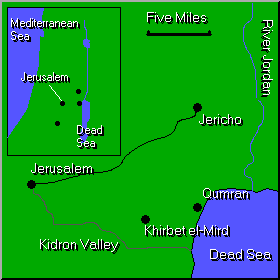 One suggestion made by researcher Manfred Lehmann is that the treasure consisted of funds accumulated throughout Israel from about 70 to 130 A.D. This was a time between two major revolts in Israel against the Romans. During this period taxes and tithes were still being collected to support the temple, but the temple had been destroyed. Since the collectors could not deliver the treasure, they buried it. Some of the evidence suggests that the scroll was placed in the cave around 70 A.D. If this was the case, the period where the treasure was gathered might have been earlier. Perhaps 25 to 75 A.D.. If this was so, the treasure might been already at the temple, but dispersed and buried with the expectation that the Romans would attack the city to put down the revolt. Something they did in 70 A.D..
One suggestion made by researcher Manfred Lehmann is that the treasure consisted of funds accumulated throughout Israel from about 70 to 130 A.D. This was a time between two major revolts in Israel against the Romans. During this period taxes and tithes were still being collected to support the temple, but the temple had been destroyed. Since the collectors could not deliver the treasure, they buried it. Some of the evidence suggests that the scroll was placed in the cave around 70 A.D. If this was the case, the period where the treasure was gathered might have been earlier. Perhaps 25 to 75 A.D.. If this was so, the treasure might been already at the temple, but dispersed and buried with the expectation that the Romans would attack the city to put down the revolt. Something they did in 70 A.D.. 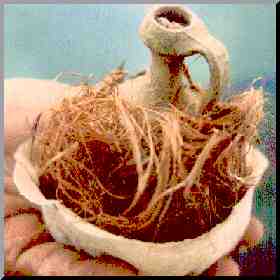
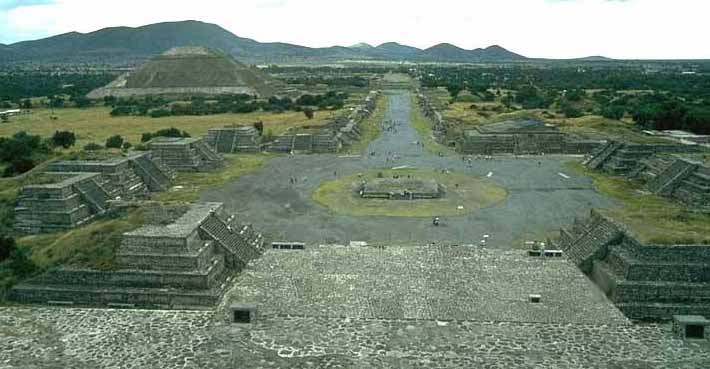
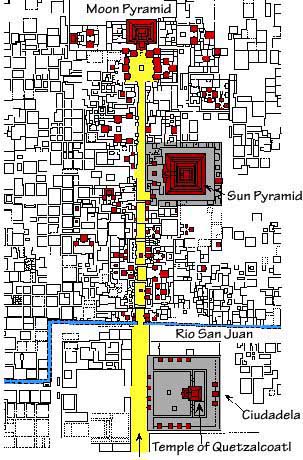
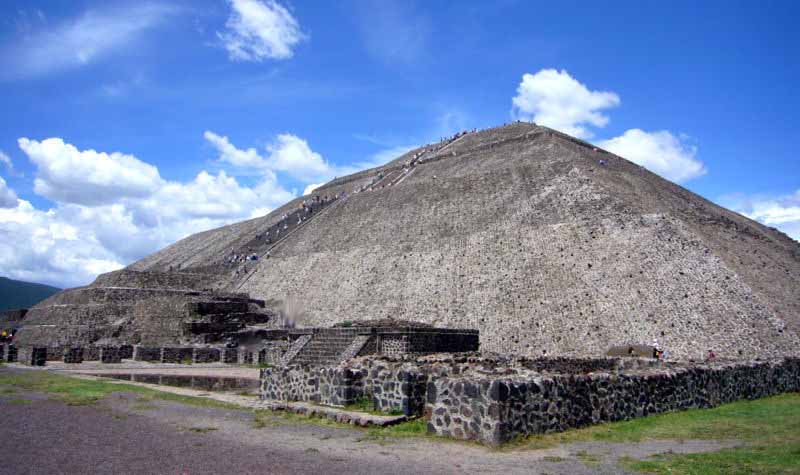




 Peru - Verano - which means summer, or dry season - possibly in association with the Pleiades ritual at the summer solstice during the dry season. A Peruvian cosmological chart from around 1613 seems to show the Pleiades. Pachacuti Yamqui, an Inca nobleman, drew the chart to show the objects that were depicted on the temple in Cusco, adding Spanish and Quechua notations.
Peru - Verano - which means summer, or dry season - possibly in association with the Pleiades ritual at the summer solstice during the dry season. A Peruvian cosmological chart from around 1613 seems to show the Pleiades. Pachacuti Yamqui, an Inca nobleman, drew the chart to show the objects that were depicted on the temple in Cusco, adding Spanish and Quechua notations. 


